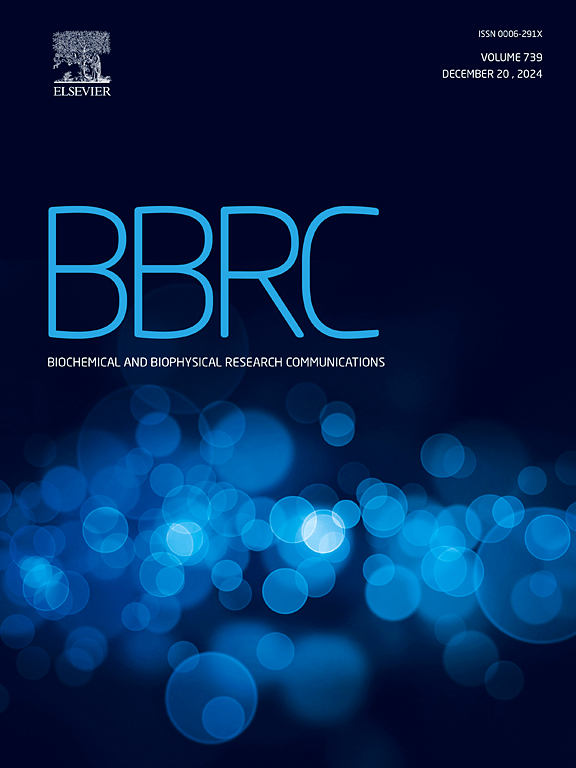Vitamin C prevents nickel accumulation in rat brain through affecting its transport via serum albumin
IF 2.5
3区 生物学
Q3 BIOCHEMISTRY & MOLECULAR BIOLOGY
Biochemical and biophysical research communications
Pub Date : 2025-07-05
DOI:10.1016/j.bbrc.2025.152314
引用次数: 0
Abstract
Nickel (Ni2+) exposure has been linked to oxidative stress, reproductive toxicity, and neurotoxicity. Human serum albumin (HSA), a major plasma transport protein, that plays a critical role in the systemic distribution of xenobiotics, including heavy metals. This study aimed to investigate how vitamin C affects the interaction between Ni2+ and HSA, and whether this interaction influences nickel accumulation in the brain.
Male rats were divided into three groups: a control group receiving vitamin C alone, a group exposed to nickel, and a group receiving both nickel and vitamin C. Atomic absorption spectroscopy revealed that co-treatment with vitamin C significantly reduced nickel accumulation in brain tissue compared to nickel exposure alone. To elucidate the underlying mechanism, in vitro and in silico approaches were employed. Spectroscopic analyses—including fluorescence quenching, site marker displacement, synchronous fluorescence, and circular dichroism (CD)—revealed that vitamin C competitively interferes with Ni2+ binding to HSA and protects the native structure of the protein from nickel-induced conformational changes. Notably, the binding affinity of Ni2+ to HSA was lower in the presence of vitamin C. Molecular dynamics simulations supported these findings, indicating structural destabilization of the Ni–HSA complex when vitamin C was present. Together, these results suggest that vitamin C modulates Ni2+ transport by altering its binding to HSA, which may partly explain its protective effect against nickel-induced neurotoxicity. Further research is needed to fully elucidate transport mechanisms of nickel across the blood–brain barrier.
维生素C通过影响镍在血清白蛋白中的转运来阻止镍在大鼠脑中的积累
镍(Ni2+)暴露与氧化应激、生殖毒性和神经毒性有关。人血清白蛋白(HSA)是一种主要的血浆转运蛋白,在包括重金属在内的外源药物的全身分布中起着关键作用。本研究旨在探讨维生素C如何影响Ni2+和HSA之间的相互作用,以及这种相互作用是否影响镍在大脑中的积累。雄性大鼠被分为三组:对照组单独接受维生素C,一组暴露于镍,一组同时接受镍和维生素C。原子吸收光谱显示,与单独接触镍相比,维生素C联合治疗显著减少了脑组织中镍的积累。为了阐明其潜在的机制,我们采用了体外和计算机方法。光谱分析——包括荧光猝灭、位点标记位移、同步荧光和圆二色性(CD)——揭示了维生素C竞争性地干扰Ni2+与HSA的结合,并保护蛋白质的天然结构免受镍诱导的构象变化。值得注意的是,当维生素C存在时,Ni2+对HSA的结合亲和力较低。分子动力学模拟支持这些发现,表明当维生素C存在时,Ni-HSA复合物的结构不稳定。总之,这些结果表明,维生素C通过改变Ni2+与HSA的结合来调节Ni2+的转运,这可能部分解释了其对镍诱导的神经毒性的保护作用。需要进一步的研究来充分阐明镍在血脑屏障中的转运机制。
本文章由计算机程序翻译,如有差异,请以英文原文为准。
求助全文
约1分钟内获得全文
求助全文
来源期刊
CiteScore
6.10
自引率
0.00%
发文量
1400
审稿时长
14 days
期刊介绍:
Biochemical and Biophysical Research Communications is the premier international journal devoted to the very rapid dissemination of timely and significant experimental results in diverse fields of biological research. The development of the "Breakthroughs and Views" section brings the minireview format to the journal, and issues often contain collections of special interest manuscripts. BBRC is published weekly (52 issues/year).Research Areas now include: Biochemistry; biophysics; cell biology; developmental biology; immunology
; molecular biology; neurobiology; plant biology and proteomics

 求助内容:
求助内容: 应助结果提醒方式:
应助结果提醒方式:


